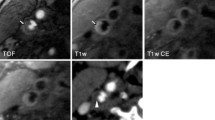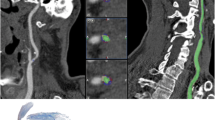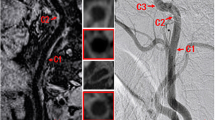Abstract
Introduction
We aimed to assess the relationship between atherosclerotic carotid plaque composition analyzed using multidetector computed tomography (MDCT) and the appearance of new ischemic lesions detected by diffusion-weighted images (DWI) after carotid artery stenting (CAS).
Methods
We quantitatively and qualitatively analyzed plaque characteristics in carotid arteries using MDCT before CAS in 19 patients. Carotid plaques were expediently subdivided into four components with Hounsfield unit (HU) values of <0, 0–60, 60–130, and >600. The incidence of distal embolism was evaluated with DWI. Pearson's correlation analyses were used to assess the association between plaque composition and the incidence of cerebral embolization.
Results
Fifteen patients (79%) demonstrated new DWI lesions after CAS. High-signal DWIs were noted as follows: one in six patients, 2 ~ 5 in five patients, 6 ~ 10 in two patients, and >10 in two patients. The mean volumes of the plaque components for HU < 0, 0–60, 60–130, and >600 were 5.4, 200, 260, and 59 mm3, respectively. There was a strong correlation between the number of high-signal DWI lesions in the ipsilateral side and the plaque volume of HU < 0 (r = 0.927; P < 0.0001). There was a moderate correlation between the number of high-signal DWI lesions and the plaque volume of HU 0–60 (r = 0.568; P = 0.0099) and the sum total of HU < 0 and HU 0–60 (r = 0.609; P = 0.0047).
Conclusions
Quantitative and qualitative tissue characterization of carotid plaques using MDCT might be a useful predictor for silent ischemic lesions after CAS.


Similar content being viewed by others
References
CAVATAS investigators (2001) Endovascular versus surgical treatment in patients with carotid stenosis in the Carotid and Vertebral Artery Transluminal Angioplasty Study (CAVATAS): a randomised trial. Lancet 357:1729–1737
Yadav JS, Wholey MH, Kuntz RE, Fayad P, Katzen BT, Mishkel GJ, Bajwa TK, Whitlow P, Strickman NE, Jaff MR, Popma JJ, Snead DB, Cutlip DE, Firth BG, Ouriel K (2004) Protected carotid-artery stenting versus endarterectomy in high-risk patients. N Engl J Med 351:1493–1501
Lev EI, Patel RT, Maresh KJ, Guthikonda S, Granada J, DeLao T, Bray PF, Kleiman NS (2006) Aspirin and clopidogrel drug response in patients undergoing percutaneous coronary intervention: the role of dual drug resistance. J Am Coll Cardiol 47:27–33
Ringleb PA, Allenberg J, Bruckmann H, Eckstein HH, Fraedrich G, Hartmann M, Hennerici M, Jansen O, Klein G, Kunze A, Marx P, Niederkorn K, Schmiedt W, Solymosi L, Stingele R, Zeumer H, Hacke W (2006) 30 day results from the SPACE trial of stent-protected angioplasty versus carotid endarterectomy in symptomatic patients: a randomised non-inferiority trial. Lancet 368:1239–1247
Ederle J, Dobson J, Featherstone RL, Bonati LH, van der Worp HB, de Borst GJ, Lo TH, Gaines P, Dorman PJ, Macdonald S, Lyrer PA, Hendriks JM, McCollum C, Nederkoorn PJ, Brown MM (2010) Carotid artery stenting compared with endarterectomy in patients with symptomatic carotid stenosis (International Carotid Stenting Study): an interim analysis of a randomised controlled trial. Lancet 375:985–997
Schnaudigel S, Groschel K, Pilgram SM, Kastrup A (2008) New brain lesions after carotid stenting versus carotid endarterectomy: a systematic review of the literature. Stroke 39:1911–1919
Biasi GM, Froio A, Diethrich EB, Deleo G, Galimberti S, Mingazzini P, Nicolaides AN, Griffin M, Raithel D, Reid DB, Valsecchi MG (2004) Carotid plaque echolucency increases the risk of stroke in carotid stenting: the Imaging in Carotid Angioplasty and Risk of Stroke (ICAROS) study. Circulation 110:756–762
Yamada K, Kawasaki M, Yoshimura S, Enomoto Y, Asano T, Minatoguchi S, Iwama T (2009) Prediction of silent ischemic lesions after carotid artery stenting using integrated backscatter ultrasound and magnetic resonance imaging. Atherosclerosis 208:161–166
Timaran CH, Rosero EB, Martinez AE, Ilarraza A, Modrall JG, Clagett GP (2010) Atherosclerotic plaque composition assessed by virtual histology intravascular ultrasound and cerebral embolization after carotid stenting. J Vasc Surg 52:1188–1194
Altaf N, MacSweeney ST, Gladman J, Auer DP (2007) Carotid intraplaque hemorrhage predicts recurrent symptoms in patients with high-grade carotid stenosis. Stroke 38:1633–1635
de Weert TT, Ouhlous M, Meijering E, Zondervan PE, Hendriks JM, van Sambeek MR, Dippel DW, van der Lugt A (2006) In vivo characterization and quantification of atherosclerotic carotid plaque components with multidetector computed tomography and histopathological correlation. Arterioscler Thromb Vasc Biol 26:2366–2372
de Weert TT, Ouhlous M, Zondervan PE, Hendriks JM, Dippel DW, van Sambeek MR, van der Lugt A (2005) In vitro characterization of atherosclerotic carotid plaque with multidetector computed tomography and histopathological correlation. Eur Radiol 15:1906–1914
Koelemay MJ, Nederkoorn PJ, Reitsma JB, Majoie CB (2004) Systematic review of computed tomographic angiography for assessment of carotid artery disease. Stroke 35:2306–2312
Saam T, Hatsukami TS, Takaya N, Chu B, Underhill H, Kerwin WS, Cai J, Ferguson MS, Yuan C (2007) The vulnerable, or high-risk, atherosclerotic plaque: noninvasive MR imaging for characterization and assessment. Radiology 244:64–77
Takaya N, Yuan C, Chu B, Saam T, Underhill H, Cai J, Tran N, Polissar NL, Isaac C, Ferguson MS, Garden GA, Cramer SC, Maravilla KR, Hashimoto B, Hatsukami TS (2006) Association between carotid plaque characteristics and subsequent ischemic cerebrovascular events: a prospective assessment with MRI—initial results. Stroke 37:818–823
Chen Z, Ichetovkin M, Kurtz M, Zycband E, Kawka D, Woods J, He X, Plump AS, Hailman E (2010) Cholesterol in human atherosclerotic plaque is a marker for underlying disease state and plaque vulnerability. Lipids Health Dis 9:61
Kolodgie FD, Burke AP, Nakazawa G, Cheng Q, Xu X, Virmani R (2007) Free cholesterol in atherosclerotic plaques: where does it come from? Curr Opin Lipidol 18:500–507
Rapp JH, Connor WE, Lin DS, Inahara T, Porter JM (1983) Lipids of human atherosclerotic plaques and xanthomas: clues to the mechanism of plaque progression. J Lipid Res 24:1329–1335
Small DM (1988) George Lyman Duff memorial lecture. Progression and regression of atherosclerotic lesions. Insights from lipid physical biochemistry. Arteriosclerosis 8:103–129
Kastrup A, Nagele T, Groschel K, Schmidt F, Vogler E, Schulz J, Ernemann U (2006) Incidence of new brain lesions after carotid stenting with and without cerebral protection. Stroke 37:2312–2316
Pinero P, Gonzalez A, Mayol A, Martinez E, Gonzalez-Marcos JR, Boza F, Cayuela A, Gil-Peralta A (2006) Silent ischemia after neuroprotected percutaneous carotid stenting: a diffusion-weighted MRI study. AJNR Am J Neuroradiol 27:1338–1345
Rapp JH, Wakil L, Sawhney R, Pan XM, Yenari MA, Glastonbury C, Coogan S, Wintermark M (2007) Subclinical embolization after carotid artery stenting: new lesions on diffusion-weighted magnetic resonance imaging occur postprocedure. J Vasc Surg 45:867–872
Bonati LH, Jongen LM, Haller S, Flach HZ, Dobson J, Nederkoorn PJ, Macdonald S, Gaines PA, Waaijer A, Stierli P, Jager HR, Lyrer PA, Kappelle LJ, Wetzel SG, van der Lugt A, Mali WP, Brown MM, van der Worp HB, Engelter ST (2010) New ischaemic brain lesions on MRI after stenting or endarterectomy for symptomatic carotid stenosis: a substudy of the International Carotid Stenting Study (ICSS). Lancet Neurol 9:353–362
Vermeer SE, Prins ND, den Heijer T, Hofman A, Koudstaal PJ, Breteler MM (2003) Silent brain infarcts and the risk of dementia and cognitive decline. N Engl J Med 348:1215–1222
Conflict of interest
We declare that we have no conflict of interest.
Author information
Authors and Affiliations
Corresponding author
Rights and permissions
About this article
Cite this article
Uchiyama, N., Misaki, K., Mohri, M. et al. Association between carotid plaque composition assessed by multidetector computed tomography and cerebral embolism after carotid stenting. Neuroradiology 54, 487–493 (2012). https://doi.org/10.1007/s00234-011-0920-9
Received:
Accepted:
Published:
Issue Date:
DOI: https://doi.org/10.1007/s00234-011-0920-9




